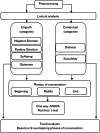Changes in Mental State for Help-Seekers of Lifeline Australia's Online Chat Service: Lexical Analysis Approach
- PMID: 40540433
- PMCID: PMC12204239
- DOI: 10.2196/63257
Changes in Mental State for Help-Seekers of Lifeline Australia's Online Chat Service: Lexical Analysis Approach
Abstract
Background: Mental health challenges are escalating globally, with increasing numbers of individuals accessing crisis helplines through various modalities. Despite this growing demand, there is limited understanding of how crisis helplines benefit help-seekers over the course of a conversation. Affective computing has the potential to transform this area of research, yet it remains relatively unexplored, partly due to the scarcity of available helpline data.
Objective: This study aimed to explore the feasibility of using lexical analysis to track dynamic changes in the mental state of help-seekers during online chat conversations with a crisis helpline.
Methods: Lexical analysis was conducted on 6618 deidentified online chat transcripts collected by Lifeline Australia between April and June 2023 using the validated Empath lexical categories of Positive Emotion, Negative Emotion, Suffering, and Optimism. Furthermore, 2 context-specific categories, Distress and Suicidality, were also developed and analyzed to reflect crisis support language. Correlation analyses evaluated the relationships between the 6 lexical categories. One-way ANOVAs assessed changes in each lexical category across 3 conversation phases (beginning, middle, and end). Trend analyses using regression modeling examined the direction and strength of changes in lexical categories across 9 overlapping conversation windows (20% size and 50% step overlap).
Results: Significant changes were observed across conversation phases. The context-specific categories showed the strongest improvements from the beginning to end phase of conversation, with a large reduction in Distress (d=0.79) and a moderate reduction in Suicidality (d=0.49). The most frequently occurring terms representing Distress were "hard," "bad," and "down," and for Suicidality were "suicide," "stop," and "hurt." The negatively framed Empath categories also significantly reduced, with moderate effect sizes for Suffering (d=0.49) and Negative Emotion (d=0.39). There were also significant but small reductions in the positively framed Empath categories of Positive Emotion (d=0.15) and Optimism (d=0.07) from the beginning to end phase of conversation. Correlation coefficients indicated the lexical categories captured related but distinct constructs (r=.34 to r=0.82). Trend analyses revealed a consistent downward trajectory across most lexical categories. Distress showed the steepest decline (slope=-0.15, R²=0.97), followed by Suffering (slope=-0.11, R²=0.96), Negative Emotion (slope=-0.10, R²=0.69), and Suicidality (slope=-0.06, R²=0.88). Positive Emotion showed a slight negative trend (slope=-0.04, R²=0.54), while Optimism remained relatively stable across the conversation windows (slope=0.01, R²=0.13).
Conclusions: This study demonstrates the feasibility of using lexical analysis to represent and monitor mental state changes during online crisis support interactions. The findings highlight the potential for integrating affective computing into crisis helplines to enhance service delivery and outcome measurement. Future research should focus on validating these findings and exploring how lexical analysis can be applied to improve real-time support to those in crisis.
Keywords: ANOVA; Lexical; affective computing; caregivers; chat; crisis helpline; crisis support; digital health; digital mental health; distress; e-health; emotion; feasibility study; help-seeker; help-seeking; lexical analysis; mental health; mental health intervention; mental state; online communities; online support; outcomes; suicidal; suicide; support service.
© Kelly Mazzer, Sonia Curll, Hakar Barzinjy, Roland Goecke, Mark Larsen, Philip J Batterham, Nickolai Titov, Debra Rickwood. Originally published in JMIR Formative Research (https://formative.jmir.org).
Conflict of interest statement
Figures




Similar articles
-
Home treatment for mental health problems: a systematic review.Health Technol Assess. 2001;5(15):1-139. doi: 10.3310/hta5150. Health Technol Assess. 2001. PMID: 11532236
-
Health professionals' experience of teamwork education in acute hospital settings: a systematic review of qualitative literature.JBI Database System Rev Implement Rep. 2016 Apr;14(4):96-137. doi: 10.11124/JBISRIR-2016-1843. JBI Database System Rev Implement Rep. 2016. PMID: 27532314
-
How to Implement Digital Clinical Consultations in UK Maternity Care: the ARM@DA Realist Review.Health Soc Care Deliv Res. 2025 May;13(22):1-77. doi: 10.3310/WQFV7425. Health Soc Care Deliv Res. 2025. PMID: 40417997 Review.
-
Effectiveness and safety of vitamin D in relation to bone health.Evid Rep Technol Assess (Full Rep). 2007 Aug;(158):1-235. Evid Rep Technol Assess (Full Rep). 2007. PMID: 18088161 Free PMC article.
-
Effectiveness of family interventions on psychological distress and expressed emotion in family members of individuals diagnosed with first-episode psychosis: a systematic review.JBI Database System Rev Implement Rep. 2017 Apr;15(4):1057-1079. doi: 10.11124/JBISRIR-2017-003361. JBI Database System Rev Implement Rep. 2017. PMID: 28398985
References
-
- Preventing suicide: a resource for establishing a crisis line. World Health Organization. 2018. [13-05-2024]. https://apps.who.int/iris/bitstream/handle/10665/311295/WHO-MSD-MER-18.4... URL. Accessed.
-
- Mokkenstorm JK, Eikelenboom M, Huisman A, et al. Evaluation of the 113 online suicide prevention crisis chat service: outcomes, helper behaviors and comparison to telephone hotlines. Suicide & Life Threat Behav. 2017 Jun;47(3):282–296. doi: 10.1111/sltb.12286. https://onlinelibrary.wiley.com/toc/1943278x/47/3 URL. doi. - DOI - PubMed
MeSH terms
LinkOut - more resources
Full Text Sources
Medical
Research Materials
Miscellaneous

